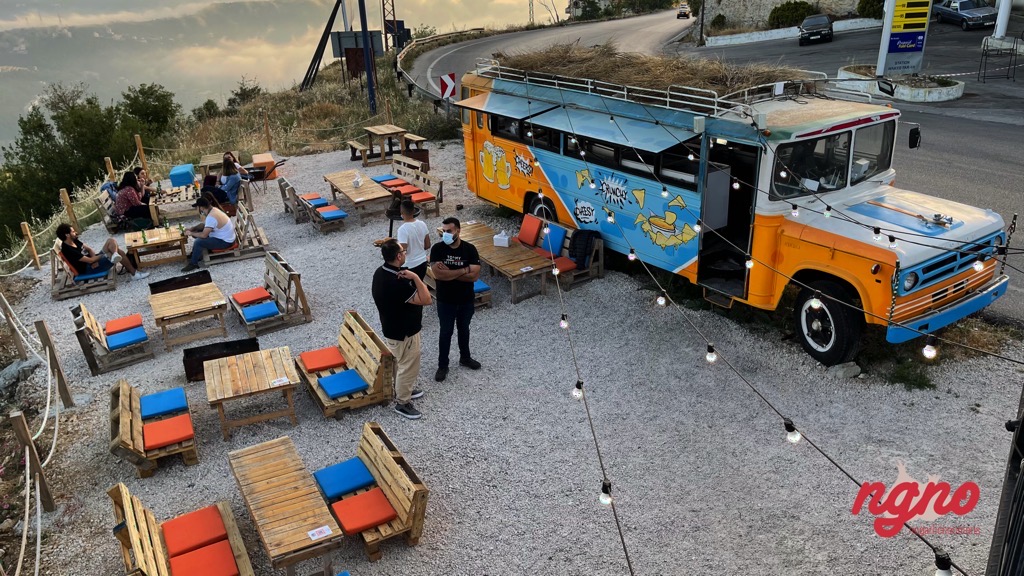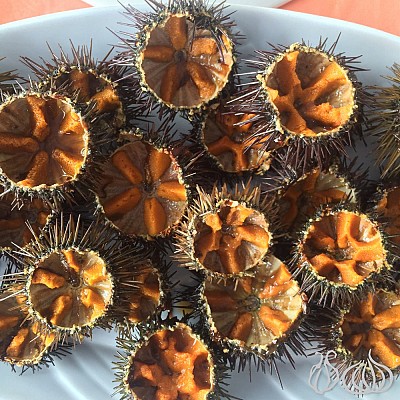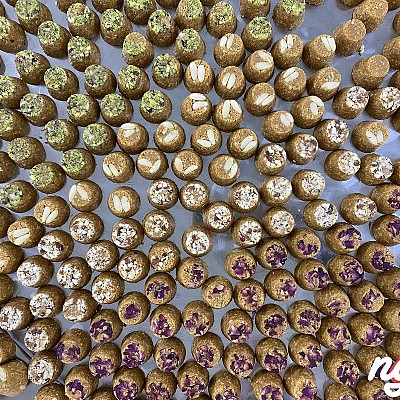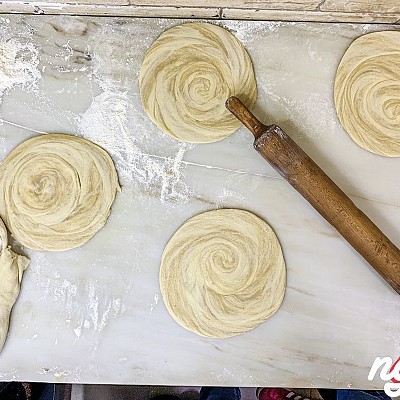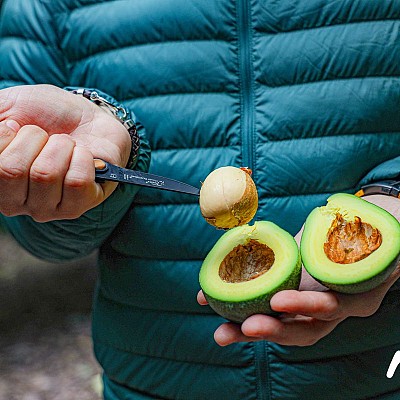Our trip in the district of Jbeil, home to over 90 villages, started from the Amchit Port. The port is closed off and houses a co-op and a restaurant. At the restaurant, you eat fish right out of water. Along with the port is Boulevard Amchit, a walkway great for a 6 a.m. jog or a leisurely stroll with loved ones.
Our first stop was at Furn el Sabaya, which has been open for 27 years. The ladies explained that, at first, they started with manakish. Soon enough, they began to add more and more varieties. Now, they have everything from sweet to savory. I was surprised to find out they serve vegan shawarma; it looks and tastes just like meat but it’s made out of wheat.
Next, we went to a miniature craftsmanship museum in Amchit. The museum contains displays of miniature working tools that Lebanese craftsmen would use; it has everything from carpentry tools to a farmer’s pitchfork. The 500 pieces were all made by Maa’llem Tanyous when he was 77 years old. The museum doesn’t charge entry fees. His daughter, who runs the museum now, showed us around, and offered us a delicious biscuit-like dessert she calls Sfuf Rafika, named after her mother and their creator. We, then, headed to meet Youssef Najam, a retired man who makes straw baskets, hats, and placemats. Youssef took on the hobby during quarantine last year and hasn’t stopped since.
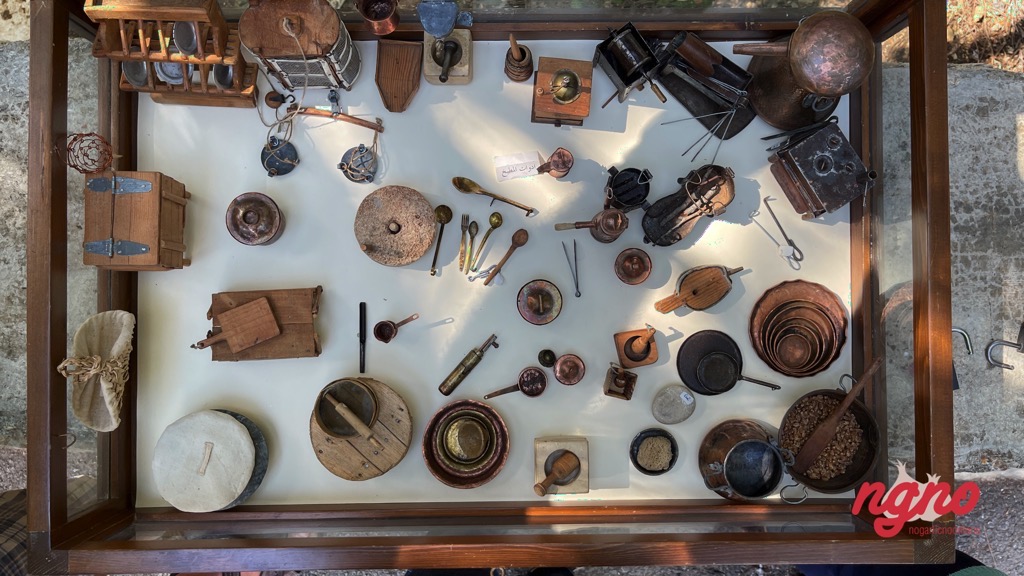
We met up with Mazen Rizk again, and strolled through Amchit to discuss its history and significance. We stopped at a church built from protruding stones. Mazen explained that the stones are a type of carved stone and evidence to the existence of previous temples, whether roman or pagan, at this spot. We passed by the house of Ernest Renan, a French philosopher who was on an archaeological expedition in Amchit. In fact, it is in Amchit where he was inspired to write “The Life of Jesus”, his most influential work. Mission to Phoenicia, the book of his findings, serves as a pillar of Lebanese archeology and history.
We stopped by Rafic Kallab’s carpentry. In the back of the carpentry is Rafic’s atelier where he makes everything from swords to the Oud and other instruments. We went into Issa’s Pickles shop, where they pickle just about everything. They even have pickled seaweed which can be served with seafood or anything else.
Joseph, who’s been helping us find all these hidden gems, made us stop at Samket Amchit. Samket Amchit has been operating for 44 years. They open from 5 a.m. to 5 p.m from Mondays to Saturdays. They also have a bar area where you can order a few dishes or grab a sandwich for the road. At the bar, I had butter-like raw fish that just dissolved in my mouth among other things.
Next up on our road trip was Hasrayel. We stopped at Furn Abu Chadi. There, we talked to Jean Charbel, a resident, who explained that Hasrayel is more of an industrial town. Inside, we were introduced to the baker, Michel Charbel, who made us an incredible four-cheese-filled Zaatar pie.
We stopped at XXX where we had raw kafta with basil, lemon juice, and olive oil as well as raw kebbeh with lemon zest. They tasted delicious. I was also promised lamb cooked inside a clay pot when we return from our tour. With the clay pot on the coal, we headed out to see the rest of village. Of course, when we stopped by the church of Marjeryes, we had to check out the bell. We walked around an oak-tree-filled area until we reached another church. The church unexpectedly is located in a remote area. It has large columns, a staircase, and only 3 walls. People or the bride, in case of weddings, would walk down the stairs to reach an outdoor reception area with a view of the Tartij’s oak trees. We headed back to the restaurant for lunch. As promised, I had superb lamb meat cooked in the clay pot with potatoes and lemon slices.
After lunch, we headed to the Monastery of Lady of Mayfouk. Looking at the bell, I thought it wasn’t made in Lebanon because of the intricate carvings and the carving of the Virgin Mary. Turning to the other side, I realized I was wrong as I read the names Hatem Nafaa and Elias Salman Nafaa. The bell was made in 1858, probably one of the oldest in Lebanon. Inside the monastery, we were told that the monastery is working on several projects including an agricultural project and a dairy farm. The school will be celebrating its 100th anniversary next year. The monastery is located on a path with several other churches for any religious tourists coming.
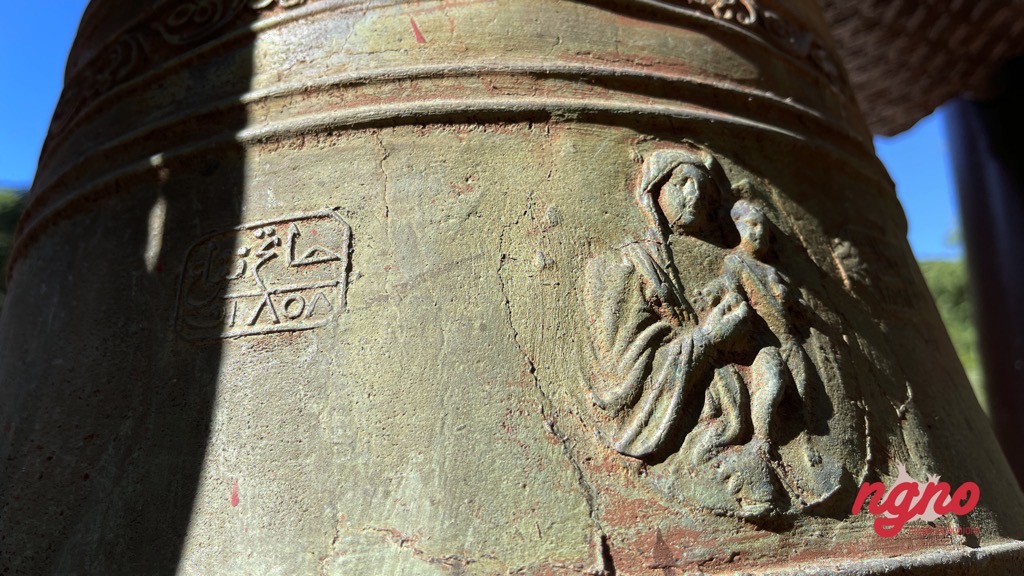
After that, we stopped at Nab’al Jawz restaurant in Mayfouk, a family restaurant that opened in 1943. The restaurant boasts a view of the spring and walnut trees as well as a feast of Lebanese mezze.
Although we weren’t planning on visiting the Covent of Lady Elige in Mayfouk this time around, we stopped there again before heading to Ghalboun. The name Elige comes from the word the God of Depths in Aramaic or Eligios, the goddess of the sun since it was an ancient pagan temple. Just like last time, I was taken by the energy of the convent.
In Ghalboun, we met with the mayor who’s been working on promoting ecotourism in Ghalboun. First, Ghalboun has 2 guesthouses known as Byout Ghalboun. The houses, according to the mayor, have been renovated to feel like 5-star hotels. The first house, Beyt el Baydar, has 4 rooms, each with their own TV and bathroom, as well as a pool. The second house, Beyt el Dayaa, consists of 3 floors with a pool as well. On our way to Domaine Saint Gabriel winery, the mayor gave us a glimpse of how it all started. He had decided to invest in the village, rather than somewhere else to set an example. As such, he bought the houses and renovated them.
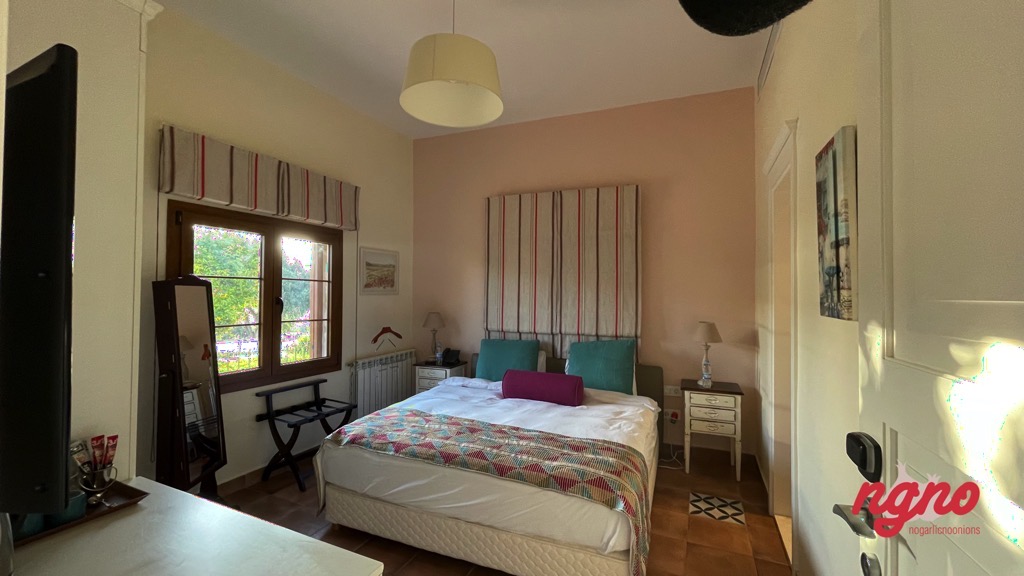
At the Domaine Saint Gabriel winery, we stepped out near the vineyards. There, the mayor introduced us to the winery and its operations. The winery was established in 2013. It currently produces 18,000 bottles out of the 18,000 vines it has. However, starting this year, production will be increased to 40,000 bottles. Inside, there are wine barrels and wine clay vessels. The barrels can be used once or twice and are made of American or French wood. Unlike the barrels, the clay vessels can be used multiple times. There, I tasted their white, rosé, and red wine. The white wine had an impeccable color. The rosé tasted like a fruit salad. The red wine was very enjoyable. All the wines were incredible.
Next, we headed to La Cave D’Hote, a restaurant open year-round that serves international food as well as Lebanese mezze. It was opened specifically with the visitors of Byout Ghalboun in mind.
Wrapping up, we headed back to our guesthouse to get a good night’s sleep before the next day of our trip in the Jbeil district.
We kicked off our next day in the Jbeil District with breakfast at the guesthouse. We were presented with a feast of jams, foul, labneh, and all sorts of bread.
Round 2 of breakfast was at the village’s bakery. We had a manousheh that was as crispy as a wafer. We also had an egg frittata dipped in labneh. We ended our meal with a flatbread covered in sugar, sesame, butter, and olive oil. It was divine. I was intrigued by a map of Maad that was on the road. The map contains all the main areas of Maad for visitors. Then, we headed to Rami Sadaka’s bakery, where he makes his dough without milk. He lets his dough rest overnight to make up for the fact that he doesn’t use a lot of yeast. Our next stop was at Al Ghrawi Establishment in Mounsef, run by Walid Al Ghrawi. They make straw and wicker handmade crafts, everything from bags to placemats.
After that, we headed to Blat to meet the town's mayor. He told us that Blat is around 0-550 meters above sea level. Previously, 3 villages were referred to as Blat. In 1913, Blat was composed of 13 farming communities. Each farming community would have about 20 families. Today, Blat has 35,000 residents because of its large residential areas.
On our way, we stopped by a church to check out their bell. Carved on it is the name Nafaa without a date. It seems to have been made at the start of the century, though.
We headed to the Ibrahin river. Along the way, we saw numerous old houses, one of which is over 90 years old. We also stopped by Ernest Basil's house. Ernest makes handmade items, whether that be souvenirs, tablecloths, or pictures. We also met with Sabine Gemayel, who paints on porcelain. She has an atelier called Troiseme Art.
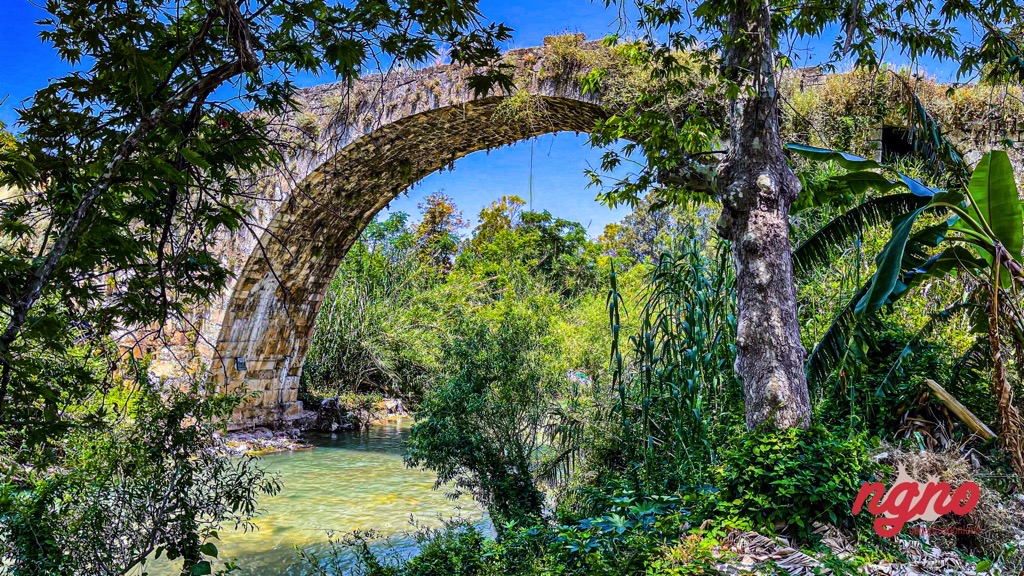
At Em el Khayrat, we met Mary George Hattem, who gave us an overview of what they do. Em el Khayrat specializes in dairy production with 100% natural cow milk. They don’t use preservatives. They also make all traditional dairy products, laban, labneh, areeshe, kishek, akkawi cheese, halloumi cheese, and even laban ayran—I grabbed one for the road. They’re planning on making more European cheeses.
At Adonis valley in Fatre, we talked to Fadi Daw, an agricultural engineer who makes certified organic preserves. They don’t use preservatives. Instead, they rely on a technique where they place the product in a bain-marie and then cool it. This preserves the product for about a year.
Next, we headed to Akkoura. We passed by the Rouiess river, named after the Greek god Ares. The Roueiss river meets with the Afqa river to form the Ibrahim river. Our guide, Elie Saab, gave me my helmet before we headed into the grotto. His helmet, he explained, came with a gas bottle that lit a flame on top so we could see. The Akkoura grotto is divided into 3 levels. As we head into the grotto, we’re told to wait for a few moments so our pupils can adjust to the new light levels. We walked through the grotto where our guide pointed out the different types of crystals the water forms. We reached a chamber with a hole in the wall. Elie said that the bats hang on to the edge of the hole by their feet. As we leave the grotto and come back to an area with regular temperatures —it was 17 degrees inside the cave— I was hit with how great of an experience it was. The grotto is left as is, wild. Unlike Jeita, the grotto is unkempt. Outside the grotto, the floor is etched. We were told that that was where the ancient residents of the area made wine. After that, we visited a one-of-a-kind statue of the Virgin Mary carrying Jesus over her head. Then, Elie took us to a restaurant called Azawardi that specializes in Lebanese food. They also have bungalows that can be rented for the night. After Azawardi, Roy and I stopped at Bouzet Sami. They have a branch in Laklouk and a branch in Zouk. The ice cream was great. It wasn’t Italian but it wasn’t Arabic either. It was something in between, an interesting middle.
In Annaya, we stopped at Ayloul, a Lebanese restaurant owned by Marc Abboud. It’s been open for 3 years. My friends and I were presented with a variety of dishes including a special labneh. The hummus was as smooth as mayonnaise.
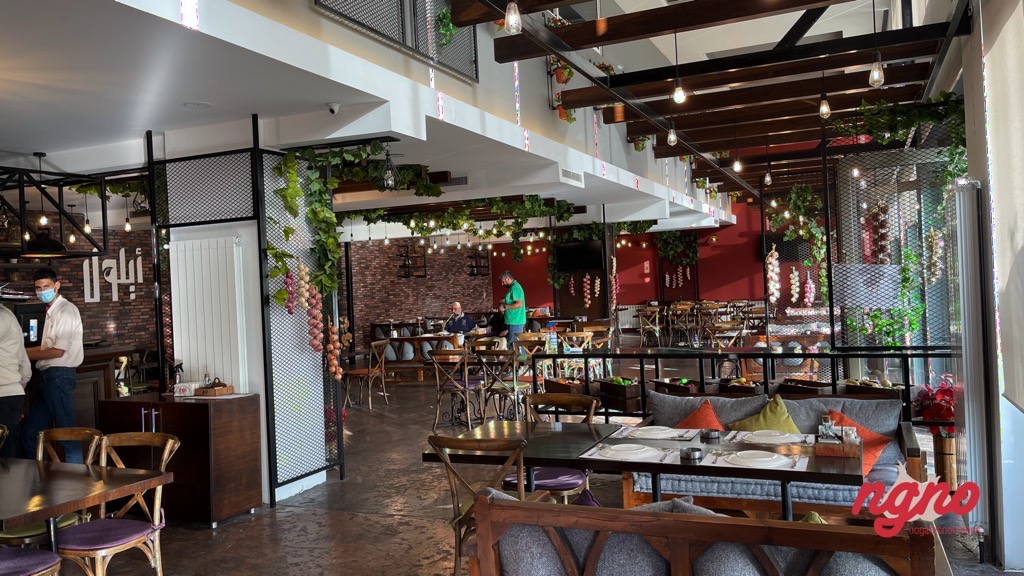
We wrapped up our trip at Gazdaro’s for dessert. Last time, we came to Gazdaro and had burgers, Saj, and salads. This time, we had a crepe and a blueberry cheesecake. The chocolate and Oreo crepe was unconventional. The chocolate was delicious and the crunchiness of the Oreos at the end was superb. The cheesecake looked homemade. The cheese was so smooth and the biscuit crumbled underneath the fork. It was incredible. After 2 days in Jbeil, we truly ended our trip on a fine note.
